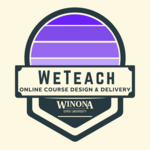WeTeach
WeTeach is a 5-week course open to anyone interested in designing high-quality online learning experiences as part of an online, hybrid, or mixed-format course. WeTeach participants work with their colleagues and course facilitators to learn how to apply evidence-based instructional design principles and standards to enhance their courses. WeTeach is an online asynchronous course with optional online and in-person meetings. Those who complete WeTeach receive a certificate and a digital badge recognizing their accomplishment.
Schedule and registration
Register for an upcoming WeTeach session by sending an email message to TLT (tlt@winona.edu).
Course format
- WeTeach is a 5-week course facilitated by experienced, professional instructional designers from WSU's Teaching, Learning, and Technology Services (TLT) team.
- WeTeach is a fully online asynchronous course, meaning there are no required class meetings. However, participants will interact with each other and the facilitators weekly via email, chat, and optional meetings.
- A basic working knowledge of D2L Brightspace, Zoom, and MediaSpace is a prerequisite for this course. Consider taking Teaching with Technology before WeTeach if you need to learn these fundamentals.
- Participants work through five content modules that include relevant readings, interactive exercises, and group activities with clear weekly outcomes.
- All participants receive a complimentary copy of Online Teaching at Its Best (Nilson & Goodson, 2021). Other options are available for those who already own this book.
- Participants should expect to spend 5-7 hours per week on course-related activities.
- D2L Brightspace will be used to manage the course, Microsoft Teams will be used for instant messaging, and Zoom will be used for office hours and online meetings.
- Participants will gain experience using several other approved and fully-supported tools (e.g., H5P) they might decide to use in their own courses.
- Participants who complete all of the course requirements will receive a certificate of completion and a portable digital badge they can display online (e.g., on LinkedIn). The badge expires in two years, and participants can complete a WeTeach Booster course to renew it.
Course Units
Below is a description of each WeTeach unit. Each module includes online readings, videos, articles, activities, and assignments.
Module 1: Getting Started
Lesson 1: What is WeTeach All About?
Lesson 2: Introductions
Lesson 3: Plan for Success
Module 2: Designing Your Course
Lesson 1: Significant Learning
Lesson 2: Student Learning Outcomes
Lesson 3: Course Review Options
Module 3: Learning Theory, Building Content, Motivation
Lesson 1: Learning Theory
Lesson 2: Building Content
Lesson 3: Motivation
Module 4: Interaction and Engagement
Lesson 1: Regular and Substantive Interaction
Lesson 2: Communication
Lesson 3: Discussions
Module 5: Grading, Rubrics, Accessibility, and Integrity
Lesson 1: Grading
Lesson 2: Rubrics
Lesson 3: Accessibility
Lesson 4: Academic Integrity
Questions
Please contact TLT (tlt@winona.edu) if you have any questions.
More wiki articles
External links
Except where otherwise noted, text is available under the Creative Commons Attribution-NonCommercial-ShareAlike 4.0 International License.
